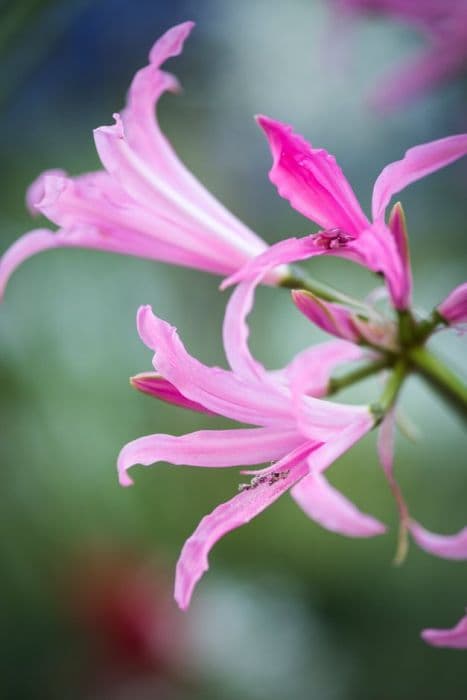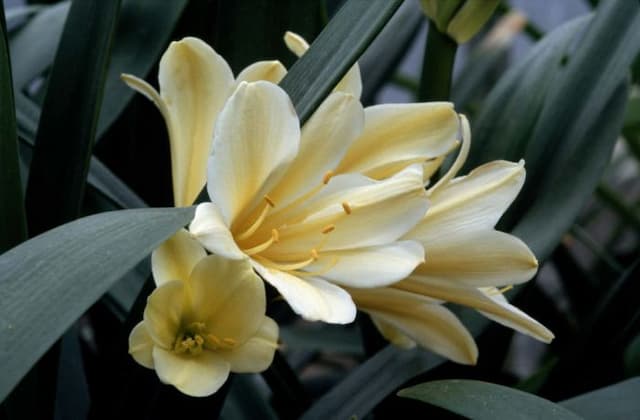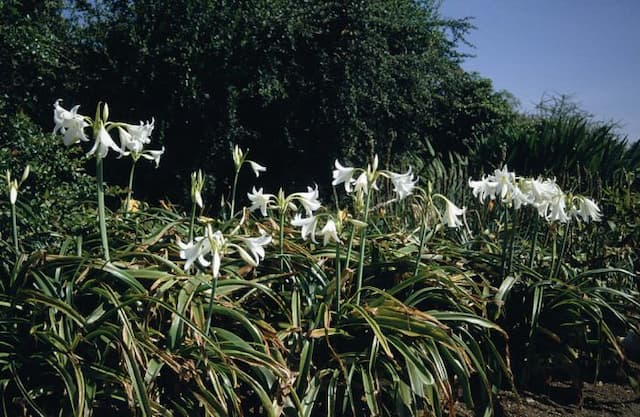Basket Lily Ismene × deflexa

ABOUT
The plant known as Ismene × deflexa, is characterized by its striking flowers which resemble those of daffodils. The blossoms are typically white with a greenish or yellow center, and have a unique, intricate structure; the petals are often curved back, forming an elegant shape. The flowers have a delightful fragrance that adds to the allure of the bloom. The foliage of the plant is also notable, with strap-shaped leaves that provide a lush backdrop for the flowers. These leaves are usually a deep green color, offering a contrasting canvas to the brilliance of the white petals. The overall appearance of this plant is one of sophistication and beauty, making it a preferred choice for garden enthusiasts looking for exotic and ornamental additions to their collections.
About this plant
 Names
NamesSynonyms
Peruvian Daffodil, Spider Lily, Sea Daffodil, Basket Flower
Common names
Hymenocallis × deflexa, Ismene festalis.
 Toxicity
ToxicityTo humans
The toxicity of the plant commonly known as the Spider Lily (Ismene × deflexa) to humans is generally considered to be low to moderate. However, it does contain alkaloids that can be harmful if ingested. Symptoms of poisoning from consuming parts of this plant may include nausea, vomiting, diarrhea, and abdominal pain. In more severe cases, it could lead to heart rhythm irregularities or neurological issues such as dizziness or tremors. It is advised to keep this plant out of reach of children and to avoid ingesting any part of it.
To pets
For pets, the Spider Lily (Ismene × deflexa) can also be toxic if ingested. The plant contains alkaloids that may cause symptoms similar to those in humans which include vomiting, diarrhea, drooling, and lethargy. In severe cases, ingestion could result in tremors, seizures, or even fatalities in pets. It is especially important to prevent pets from chewing on or consuming any part of the plant. If you suspect your pet has ingested this plant, contact your veterinarian immediately.
 Characteristics
CharacteristicsLife cycle
Perennials
Foliage type
Deciduous
Color of leaves
Green
Flower color
White
Height
1-2 feet (0.30-0.61 meters)
Spread
1-2 feet (0.30-0.61 meters)
Plant type
Bulb
Hardiness zones
8
Native area
South America
Benefits
 General Benefits
General Benefits- Ornamental Value: Ismene × deflexa, commonly known as Peruvian daffodil, has showy and fragrant flowers that add aesthetic value to gardens.
- Low Maintenance: This plant requires minimal care once established, making it suitable for gardeners of all skill levels.
- Drought Tolerance: Peruvian daffodil can withstand periods of dryness, reducing the need for frequent watering.
- Pest Resistance: It is generally resistant to pests and diseases, requiring less intervention with chemical treatments.
- Bulb Propagation: The plant propagates through bulbs, which can be easily divided and shared, making it cost-effective and community-friendly.
- Seasonal Interest: It blooms in late spring to early summer, providing a splash of color when many other plants are not in peak bloom.
- Attracts Pollinators: The flowers attract bees and other pollinators, supporting local ecosystems.
 Medical Properties
Medical PropertiesThis plant is not used for medical purposes.
 Air-purifying Qualities
Air-purifying QualitiesThis plant is not specifically known for air purifying qualities.
 Other Uses
Other Uses- Ismene × deflexa, also known as the Peruvian daffodil, can be used in perfumery for its fragrant flowers, which provide a sweet and enticing scent.
- In floral arrangements, the Peruvian daffodil's distinctive shape and fragrance can add an exotic touch to bouquets and centerpieces.
- The plant's sap can sometimes be used as a natural adhesive in small-scale, traditional applications, such as sealing small envelopes or papers.
- The bulb of the Peruvian daffodil, when crushed, could potentially serve as a natural pest repellent in gardens though this is not a common practice due to its potential toxicity.
- Dried flowers of the Ismene × deflexa may be used in potpourri blends to impart a lasting fragrance to a room or a drawer of clothes.
- Artists might use the distinct appearance of the Peruvian daffodil as a subject in botanical illustration or photography due to its unique aesthetic.
- The sturdy stems of Ismene × deflexa can be used in garden structures to provide support for climbing plants when allowed to dry and harden.
- As a natural dye source, petals of the Peruvian daffodil may provide shades of yellow or green when processed and applied to fabrics or fibers.
- During educational activities, the Peruvian daffodil can serve as an example of plant hybridization and the variation it can create within species.
- The plant can be incorporated into compost after it completes its lifecycle, enriching the soil with organic matter as it decomposes.
Interesting Facts
 Feng Shui
Feng ShuiPeruvian daffodil is not used in Feng Shui practice.
 Zodiac Sign Compitability
Zodiac Sign CompitabilityPeruvian daffodil is not used in astrology practice.
 Plant Symbolism
Plant Symbolism- Purity: Ismene × deflexa, commonly known as Peruvian Daffodil, has white blooms that symbolize purity and clean beginnings.
- Beauty: The delicate and striking appearance of the Peruvian Daffodil represents beauty and grace.
- Fragility: The fine structure of its petals can signify the fragility of life and relationships.
- Rebirth: As it is a bulbous plant that emerges after a period of dormancy, Peruvian Daffodil is often associated with renewal and the rebirth of nature.
- Inspiration: Ismene × deflexa’s beauty and fragrance are thought to inspire creativity in the arts.
 Water
WaterThe Spider Lily should be watered deeply, allowing the soil to become moderately dry between watering. On average, this could mean watering with approximately 1 gallon of water every 7 to 10 days during the growing season; however, this could vary depending on climate conditions and soil drainage. Reduce watering after the plant has bloomed and is entering dormancy. During dormancy, just a light watering every few weeks is enough to prevent the soil from completely drying out.
 Light
LightSpider Lilies perform best in bright, indirect light conditions. An ideal spot would be one where the plant receives filtered sunlight for most of the day, such as a few feet away from a south-facing window with sheer curtains. Direct sunlight should be avoided as it can scorch the leaves.
 Temperature
TemperatureSpider Lilies prefer warmer temperature conditions, thriving in an environment that stays between 70°F and 90°F. They can survive a minimum temperature of 60°F, but growth may be affected. Ideal conditions include keeping the plant away from drafts and sudden temperature changes.
 Pruning
PruningPruning Spider Lily is generally done to remove spent flowers and to tidy up any yellowing or dead foliage, enhancing the plant's appearance and focusing its energy on growth. It's best to prune the plant after blooming, typically in late summer or early fall, removing only the necessary parts of the plant.
 Cleaning
CleaningAs needed
 Soil
SoilThe Peruvian Daffodil prefers well-draining soil with a pH of 6.0 to 6.5. A mix of two parts peat, one part perlite, and one part loam is ideal to ensure proper drainage and aeration.
 Repotting
RepottingPeruvian Daffodils should be repotted every two to three years or when they become pot-bound.
 Humidity & Misting
Humidity & MistingPeruvian Daffodils thrive best in moderate to high humidity levels, around 40-60%.
 Suitable locations
Suitable locationsIndoor
Place Peruvian Daffodil in bright, indirect light with high humidity.
Outdoor
Grow Peruvian Daffodil in partial shade, protect from harsh sun.
Hardiness zone
8-10 USDA
 Life cycle
Life cycleIsmene × deflexa, also known as the Peruvian Daffodil, begins its life cycle as a bulb, entering a period of dormancy during colder months. Upon the arrival of warmer temperatures and adequate moisture in spring, the bulb sprouts and develops long, strappy leaves, along with a stalk that bears fragrant, daffodil-like flowers. After pollination, which is often assisted by insects, the flowers develop into seed pods if conditions permit. As the growing season progresses, the leaves photosynthesize, storing energy in the bulb for the next cycle. As temperatures drop, the foliage dies back, signaling the plant to enter dormancy again. This cycle repeats annually, with the bulb either producing offsets to propagate or relying on seed dispersal for the continuation of the species.
 Propogation
PropogationPropogation time
Spring to Summer
Ismene × deflexa, commonly known as Peruvian daffodil or spider lily, is often propagated through division of its bulbs, which is the most popular method. The ideal time for propagation is after the foliage has died back in the late summer or early fall. To propagate, carefully dig up the bulbs, being sure to avoid damage. Bulbs typically develop small offsets, or daughter bulbs, which can be gently separated from the parent bulb. Once separated, the new bulbs can be replanted at a depth of approximately 5 to 6 inches (roughly 12.7 to 15.2 centimeters) and spaced about 6 to 8 inches (approximately 15.2 to 20.3 centimeters) apart in well-draining soil. Ensure that the site chosen receives adequate sunlight, as Ismene × deflexa thrives in full sun to partial shade. Water the newly planted bulbs moderately to establish, and anticipate blooms the following growing season.









